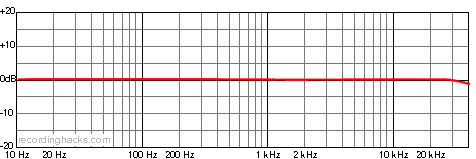Earthworks Audio QTC40 | RecordingHacks.com (original) (raw)
 Earthworks Audio QTC40
Earthworks Audio QTC40
Omnidirectional Condenser Microphone
The QTC40 is a “High Definition” omnidirectional condenser, initially released as the QTC1 in 1998. It is the most popular of Earthworks’ QTC series.
Like all the QTC mics, the QTC40 meets all of the company’s requirements for a “High Definition Microphone:”
Fast transient response (aka “impulse response”) … “The impulse response is the single best measure of the overall sonic accuracy and fidelity of a microphone. “
Fast diaphragm settling time … “If the diaphragm is still vibrating from the sounds it picked up previously it will tend to mask or color many or all of the subtle sounds that follow.”
Extended frequency response … “studies have shown that acoustic sounds and overtones of musical instruments extend to beyond 100kHz.”

Minimal signal path … Pattern controls, pads, and filters can degrade the sonic qualities of the mic.
High SPL handling … Low distortion up to and beyond 140dB.
Low impedance … The mic must able to put its signal through a long cable run without signal loss.
Consistent polar pattern … maintain a consistent pickup pattern over the mic’s full frequency range, to reduce phase cancellation at the edges and “spotlighting” of higher frequencies.
The QTC40 differs from its less-expensive sibling, the QTC30, primarily in frequency response: the QTC40 is rated from 4Hz–40kHz, whereas the QTC30 is rated from 6Hz–30kHz (with wider tolerance).
Both mics have a self-noise level of 22dBA, which is somewhat high for a modern transformerless condenser microphone.
The QTC40 requires 48V phantom power. It draws 10mA, requiring a high-current P48 source for best results.
The QTC model name prefix means “Quiet / Time Coherent.” The QTC mics are called “quiet” in comparison to the TC series; the QTC’s are rated at a somewhat high 22 dBA, whereas the TC’s are even noiser, at 27dBA.
“Time Coherent” is Earthworks’ means of distinguishing the tiny omni capsule design from all the directional and larger-diaphragm condensers on the market. According to David Blackmer, other designs “smear the signal in the time domain” due to inadequacies of their design:
- larger diaphragms resonate like drumheads when excited, coloring the recorded sound.
- most mic capsules are mounted inside of a “cage” that causes resonances and reflections, introducing phase cancellation to the signal.
- Directional mics “[sample] the sound at multiple points,” reducing the mic’s accuracy.
In contrast, the tiny (~6mm) omni capsule used in QTC mics avoids all these problems, producing a very accurate, realistic, and uncolored sound.
The mic ships with a plastic clip and its individually measured frequency response calibration chart. The QTC40 is also available as a matched pair, shipped in a cherry wood box (model QTC40mp).
SoundOnSound, 1998
In my auditions, I found the QTC1 [aka QTC40] to be a very accurate, transparent microphone which conveyed even the most harmonically complex of instruments with perfect rendition. It has an extremely natural, extended and open top end … and a phenomenal bass response which really does go down to a very small number of Hz…. [M]onitoring through small nearfield speakers is unlikely to reveal the mass of subsonic information the microphone is collecting…
Using the two QTC1s as a spaced pair, the stereo imaging was sublime — not the etched, pin-point accuracy of coincident mics of course, but a velvety smooth watercolour of sound spread out before the loudspeakers.
The Earthworks Audio QTC40 is also known as: QTC1.
Specifications
| Frequency Response - OmnidirectionalClick Graph to Compare! |
|---|
 |
| Pickup Patterns | Pads & Filters |
|---|---|
| Omnidirectional (30 mV/Pa; 4 Hz - 40,000 Hz) |
| Capsule Dimensions | Impedance | SPL/Noise |
|---|---|---|
| Capsule diameter: 6mm | 100 Ohms (Low) | Max SPL: 142 dB Self-noise: 22.0 dB(A) |
| Weight | Length | Max Diameter | Interface(s) |
|---|---|---|---|
| 225g (7.94oz) | 229mm (9.02'') | 22mm (0.87'') | 3-pin XLR male (1) |
| Power Specifications |
|---|
| Requires phantom power Phantom voltage: 40 V, 10mAv |
Did we get anything wrong on this page?Please let us know!